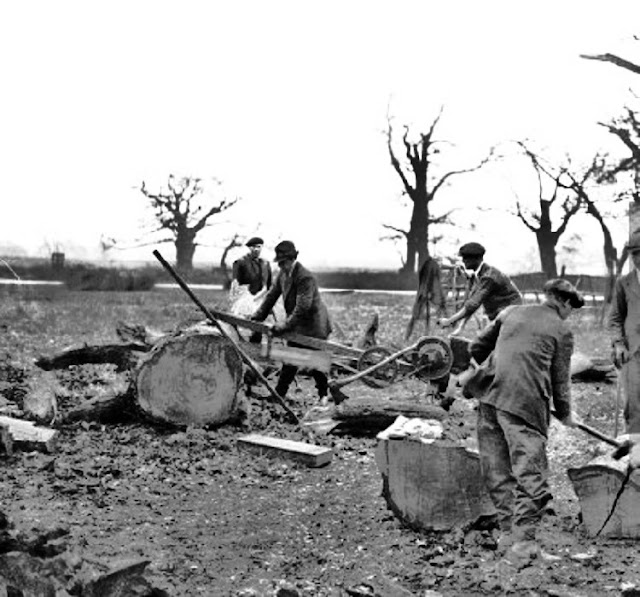The venerable, dried log, which would crackle a warming welcome for all-comers, was drug in triumph from its resting-place in the woods. During Advent as Christmas neared, a big log was brought into the home. Songs were sung a& stories told. Children danced. Offerings of food & wine and decorations were placed upon it. Personal faults, mistakes & bad choices were burned in the flame, so everyone's new year would start with a clean slate.
Early on, burning a Yule log was a celebration of the winter solstice. In Scandinavia, Yule ran from several weeks before the winter solstice to a couple weeks after. This was the darkest time of year, & the people celebrated, because days would start getting longer after the solstice. There was quite a bit of ritual & ceremony tied to the Yule log, for it marked the sun's rebirth from its southern reaches.
The Yule Log often was an entire tree, that was carefully chosen & brought into the house with great ceremony. Sometimes, the largest end of the log would be placed into the fire hearth, while the rest of the tree stuck out into the room! The log would be lit from the remains of the previous year's log which had been carefully stored away & often slowly fed into the fire through the Twelve Days of Christmas. Tradition dictated that the re-lighting process was carried out by someone with clean hands
The Yule Log often was an entire tree, that was carefully chosen & brought into the house with great ceremony. Sometimes, the largest end of the log would be placed into the fire hearth, while the rest of the tree stuck out into the room! The log would be lit from the remains of the previous year's log which had been carefully stored away & often slowly fed into the fire through the Twelve Days of Christmas. Tradition dictated that the re-lighting process was carried out by someone with clean hands
Early bards wrote of the Yule-log...
WELCOME YULE
Welcome be thou, heavenly King,
Welcome born on this morning,
Welcome for whom we shall sing,
Welcome Yule,
Welcome be ye Stephen & John,
Welcome Innocents every one,
Welcome Thomas Martyr one,
Welcome Yule.
Welcome be ye, good New Year,
Welcome Twelfth Day, both in fere,
Welcome saints, loved & dear,
Welcome Yule.
Welcome be ye, Candlemas,
Welcome be ye, Queen of Bliss,
Welcome both to more & less,
Welcome Yule.
Welcome be ye that are here,
Welcome all, & make good cheer,
Welcome all, another year,
Welcome Yule.'
‘Come bring with a noise,
My merry, merry boys,
The Christmas log to the firing,
While my good dame she
Bids ye all be free,
And drink to your heart's desiring.
With the last year's brand
Light the new block, &,
For good success in his spending,
On your psalteries play
That sweet luck may
Come while the log is a teending.
Drink now the strong beer,
Cut the white loaf here,
The while the meat is a shredding;
For the rare mince-pie,
And the plums stand by,
To fill the paste that's a kneading.'
The reference in the 2nd stanza, is to the practice of laying aside the half-consumed block after having served its purpose on Christmas Eve, preserving it carefully in a cellar or other secure place till the next Christmas, & then lighting the new log with the charred remains of its predecessor. It was believed that the preservation of last year's Christmas log was a most effective security to the house against fire. A few other traditions lingered into the 20C. It was regarded as a sign of bad-luck if a squinting person entered the hall, when the log was burning, or a bare-footed person, &, above all, a flat-footed woman! As an accompaniment to the Yule log, a candle of monstrous size, called the Yule Candle, or Christmas Candle, usually shed its light on the food table during the evening.
In Yugoslavia, the Yule Log was cut just before dawn on Christmas Eve & carried into the house at twilight. The wood itself was decorated with flowers, colored silks & gold, and then doused with wine plus an offering of grain.
In Devon & Somerset in the UK, some people collect a very large bunch of Ash twigs instead of the log. This tradition stems from a local legend that Joseph, Mary & Jesus were very cold, when the shepherds found them on Christmas Night. So the shepherds got some bunches of twigs to burn to keep them warm. In some parts of Ireland, people have a large candle instead of a log, which this is only lit on New Year's Eve and Twelfth Night. In some eastern European countries, the Yule Log is cut down on Christmas Eve morning & lit that evening.
The ashes of Yule logs were believed to be very good for plants. Today the ash from burnt wood contains a lot of "potash," which helps plants flower. But if the revelers throw the ashes from the Yule Log out on Christmas day, it is still supposedly very unlucky.





